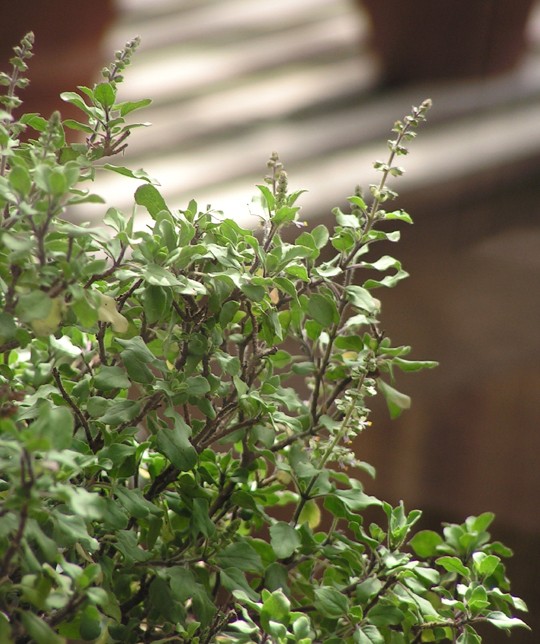Outside my study window I can see my landlady’s Tulsi plant. It’s planted in a special raised decorative pot made of terracotta with an OM painted on the side. A clay oil lamp rests on the top which is lit during pujas (ceremonial prayers or rituals). When the temple priest comes to the house to perform puja, he also says a special prayer to the Tulsi plant. Most Hindu homes have a Tulsi plant in their courtyard or garden. Sometimes a kolam is drawn in front of it. Tulsi is actually the basil plant, which is sacred to Hindus and associated with Lord Vishnu.
This plant also has many medicinal properties. I remember when I spent some time in a yoga ashram in Kerala there was a man who used to walk around with a basil leaf on his head. When I asked him why, he simply answered: “Medicine!” Tulsi is used in Ayurvedic treatments as a herbal remedy for many common ailments such as headaches, fever, colds, stomach upsets, and heart problems to name only a few. It’s purifying and antioxidant qualities can also help to reduce stress, enhance strength and stamina, and eliminate toxins. Tulsi is also believed to purify air and repel mosquitoes and other insects. Many good reasons to keep a basil plant in your home or garden!
Above photo courtesy of Wikimedia Commons.
There's even a special day called Utthana Dvadasi or Tulsi Vivaha when the Tulsi plant is worshipped. This is how it was described in the paper (Times of India):
Lord Vishnu, after a long war, killed demon Shankasura and went to sleep in his ocean of milk on Ashadha Sukla Ekadasi day. While the Protector was asleep, the world and humans were vulnerable to destruction by evil powers. On Kartika Sukla Dvadasi day, Vishnu woke up (Utthana means getting up) to perform His duty. It was on this day that the Lord married Tulsi (born by churning of the ocean of milk).
To celebrate the day, Hindu families keep a basil platform (vrindavan) on the right side of the house. The tulsi plant is watered and decorated with rangoli, haldi, kumkum, flowers and gooseberry branches. Lamps (jyothi) are lit around the vrindavan. An idol of Lord Krishna is traditionally kept near the plant and worshiped with flowers, milk and sweets like payasam made of beaten rice (avalakki), jaggery and coconut burfey. Prayers are offered for wealth, peace and prosperity and bhajans on Krishna and Tulsi are sung. Bursting of crackers is also common on this day. The belief is that by worshipping Krishna and Tulsi, the head of the family attains moksha (exemption from further transmigration) and is blessed with material and spiritual benefits.














3 comments :
Oi, achei teu blog pelo google tá bem interessante gostei desse post. Quando der dá uma passada pelo meu blog, é sobre camisetas personalizadas, mostra passo a passo como criar uma camiseta personalizada bem maneira. Até mais.
Tulsi is also supposed to bring good luck to your family/household. When I was young, my mom strictly told me not to eat tulsi leaves (yummy)!
Btw, you seem to observe everything around you and learn about them as much as possible! That's something I have rarely seen in people :).
Additional information mentioned over here and nice to here this lanka story i didn't come over this story thanks for sharing keep it up...
Post a Comment